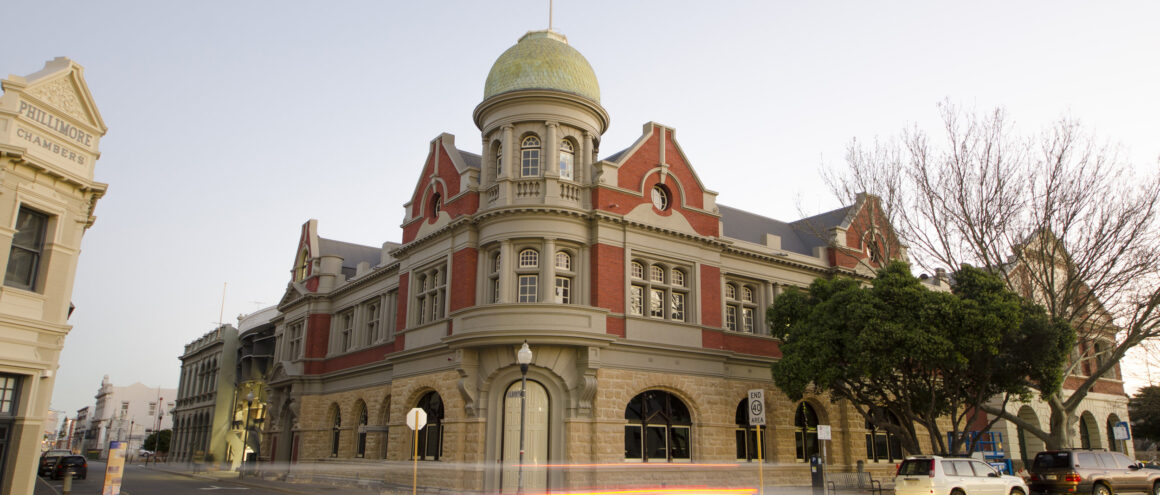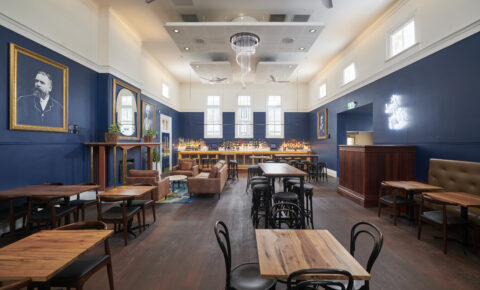Heritage Architecture: Why Conservation Matters
Heritage buildings are more than remnants of the past, they are living anchors of community identity, cultural continuity, and environmental knowledge. In Western Australia, rapid growth and renewal often place pressure on these places, yet heritage architecture gives our cities and towns authenticity, resilience, and depth.
Conserving and adapting heritage buildings is not about resisting progress. It is about making progress responsibly. Retaining existing structures reduces embodied carbon, safeguards craftsmanship, and strengthens community connection.
At Slavin Architects, we see heritage conservation as both cultural care and environmental stewardship – ensuring that the past continues to inform a sustainable future. This article explores why heritage matters, how it is protected, and why specialist expertise is essential for achieving the best outcomes.
Why Heritage Architecture Matters
Heritage buildings provide continuity in a fast-changing world. They embody stories, values, and craftsmanship that contemporary design alone cannot replicate. Their relevance can be understood in three ways:
- Cultural identity and memory – conserving significant places ensures that stories, traditions, and identities are carried forward. Fremantle’s historic streetscapes, for instance, continue to foster community pride, tourism, and belonging.
- Craftsmanship and character – heritage buildings also reveal levels of craftsmanship that contemporary construction rarely matches. The hand-tooled masonry, pressed metal ceilings, and intricate joinery found in WA’s historic civic and residential buildings embody skills and artistry that are now uncommon – often replaced with simplified, mass-produced alternatives. These details are not just decorative: they are part of the cultural and material value that heritage conservation protects.
- Environmental sustainability – conserving built fabric avoids demolition waste – which makes up nearly half of all landfill in Australia – and preserves the embodied energy already invested in durable local materials like jarrah, Donnybrook stone, and clay brick. Extending the life of a building is almost always more carbon-efficient than demolishing and starting again.
Heritage is not preservation for its own sake – it is the opportunity to work with what already has depth, character, and meaning. By building on these foundations, we enrich places with layers that new construction alone can never provide.
What Is Heritage in Architecture – and How Is It Protected?
Heritage in architecture includes buildings, places, and landscapes of cultural, historical, aesthetic, or social significance. These places are valued not only for their age or beauty, but for the stories, knowledge, and identity they embody. Heritage can include the grand and the ordinary: from a colonial-era courthouse or cathedral, to a workers’ cottage, a a town memorial, or a remnant landscape carrying stories of Country. Each represents a layer of our history and culture. In Western Australia, heritage is recognised and protected at several levels:
- State Registered Places – Buildings and sites listed on the State Register of Heritage Places, where works require approval from the Heritage Counci.
- Local Government Listings – Places identified in municipal heritage inventories or planning schemes, where local planning controls guide development and conservation.
- Community heritage – Places without statutory listing but held in high regard by local communities. Even without formal protection, these can influence planning decisions and funding priorities.
- Aboriginal Cultural Heritage (ACH) Act – Recognising that heritage includes Country, cultural practices, artefacts, and landscapes, with processes for protecting Aboriginal cultural heritage.
Determining a place’s heritage significance is rarely straightforward. By definition, heritage places have been witnesses to many eras of occupation, and their values are often layered or even in tension with one another. A building may be architecturally modest but deeply cherished by its community, or highly valued for its craftsmanship while carrying difficult histories. The Fremantle Courthouse, for example, embodies a long and at times sordid institutional history, yet today its adaptive reuse gives that history new relevance. The Roleystone Theatre began life as a community hall before becoming a cultural landmark, while Atwell House in Alfred Cove is valued for its colonial aesthetic, its local historical associations, and its present role as an arts centre. Each of these places demonstrates how significance is rarely singular – it is built up over time through layers of memory, meaning, and use. Understanding and clarifying these values is essential in deciding the right approach to conservation.
At its heart, heritage is about recognising the different ways places matter – and ensuring they continue to do so in the future. Protecting heritage does not mean freezing places in time; it means keeping them functional and adaptable while respecting their significance. Achieving this balance requires both technical expertise and sensitivity to the people and stories that give these places meaning.
Adaptive Reuse vs Demolition
Demolition is often seen as the simple option, but it erases cultural memory, generates waste, and discards materials that have already proven their durability. Adaptive reuse offers a more meaningful approach: re-imagining existing structures to serve contemporary needs while preserving heritage value. Adaptive reuse allows buildings to grow and change, adding new stories without erasing old ones.
A notable example is our transformation of the Fremantle Courthouse (1899) into a bar and restaurant. After two decades of abandonment, the building risked falling further into disrepair – a common fate for heritage places with difficult histories. The challenge was not only technical, but cultural: how do you give new life to a place shaped by judgement and incarceration, while respecting its layered history?
Our approach balanced conservation and adaptation. Original features such as the magistrate’s bench, the prisoner’s dock, and pressed plaster details were restored to remain legible. Where walls had once divided spaces, polished concrete thresholds now mark their absence – subtle cues that acknowledge what has been lost while allowing flexible new use. A contemporary pavilion was added to accommodate modern hospitality needs, deliberately distinct yet in dialogue with the original fabric.
To deepen the building’s narrative, we worked with artists to showcase the faces, names, and stories of judges, victims, and criminals whose lives were bound up with the courthouse. This ensured that even as the building changed function, its human history remained visible and accessible – reminding patrons that architecture is always shaped by the people who pass through it.
The result is a venue where Fremantle’s past and present coexist. The courthouse’s story remains visible, but its role has been transformed – from a symbol of authority and exclusion into a place of gathering and cultural life. This project demonstrates how adaptive reuse can unlock new relevance while preserving the significance that makes heritage places irreplaceable.
Why Specialist Expertise Matters
Heritage places rarely present straightforward design challenges. They carry complex layers of value that need careful interpretation. They also often demand specialist construction knowledge: traditional materials and construction methods are less common in contemporary architecture, and require expert care to conserve, repair, or adapt without loss of integrity. Without this expertise, it is all too easy for interventions to strip away what makes a place significant, or to overlook regulatory requirements that protect heritage at state and local levels.
Specialist heritage architects bring a combination of skills that go beyond conventional design:
- Regulatory knowledge – understanding how to navigate heritage approvals and engage with heritage councils, local governments, and community stakeholders.
- Technical understanding – knowing how traditional materials behave, how to conserve them, and how to introduce modern interventions without compromise.
- Conservation principles – applying internationally recognised charters and national guidelines to ensure authenticity and respect.
- Long-term responsibility – recognising that heritage is not only fabric but also stories, memory, and identity, and ensuring these are not lost in adaptation, while also balancing immediate needs with care for future generations.
Poorly considered work can cause irreversible harm – erasing craftsmanship, diminishing cultural meaning, or even breaching legislation. Done well, heritage projects enrich both place and community. Engaging a qualified heritage architect ensures projects are compliant, sensitive, and enduring.
At Slavin Architects, we see our role as both technical and cultural custodians. From Fremantle’s historic institutions to regional theatres and civic buildings, our projects demonstrate how expert care allows heritage places to remain useful, relevant, and resonant. Specialist expertise ensures that conservation is not just about compliance, but about unlocking the potential of heritage to serve communities into the future.
Heritage and Sustainability
Heritage is not only cultural; it is environmental. Many heritage places – from civic buildings to agricultural landscapes – embody practical lessons in living with climate and place. Wide verandahs, shaded arcades, cross-ventilation, and orientation to prevailing breezes are strategies seen in WA’s Federation and Interwar buildings, long before air-conditioning. Likewise, traditional gardens, irrigation channels, and remnant bushland within heritage landscapes carry ecological knowledge that shaped settlement patterns and community life. Conserving these places allows us to retain and learn from the environmental intelligence embedded within them.
At the same time, conservation itself is an act of sustainability. Reusing existing buildings avoids the waste of demolition, preserves the embodied energy already invested in materials, and extends the life of durable local resources such as jarrah, Donnybrook stone, and clay brick. Globally, the building sector is a major contributor to carbon emissions; adaptive reuse is one of the simplest and most effective ways to cut embodied carbon.
Heritage, then, is both a teacher and a partner in sustainability. It reminds us how to design with climate in mind, and it reduces our environmental impact by valuing what we already have. By conserving heritage places – whether buildings, landscapes, or cultural sites – we are not looking backwards, but acting responsibly for a resilient future.
Designing with Integrity
Every heritage project requires a balance between conservation and contemporary needs. ntegrity is the principle that keeps us grounded — ensuring that conservation is more than a technical process, and that new interventions contribute respectfully rather than compete. At Slavin Architects, our approach centres on:
- Collaboration – listening to and engaging with communities, Traditional Owners, consultants, and councils, because heritage significance is collective, not individual.
- Conservation – guided by national and international charters, and our commitment to care for Country, so both cultural and material values are protected.
- Balanced outcomes – making buildings functional and safe for today without losing what gives them meaning.
- Design clarity – adding contemporary elements that are distinct yet in dialogue with the original, avoiding mimicry or intrusion.
- Documenting stories – recording voices, histories, and cultural layers that might otherwise go unrecognised, enriching both conservation records and design outcomes.
For us, integrity is not about compromise but about coherence – ensuring that heritage places remain legible, useful, and enriched by each generation that cares for them.
Heritage Lessons for the Future
Heritage architecture is far more than a link to the past – it is an active contributor to cultural identity, sustainability, and community wellbeing. In Western Australia, embracing heritage means honouring diverse histories, reducing environmental impact, and creating places that are meaningful and enduring.
Heritage teaches us how to build with durability, authenticity, and community at the centre. It reminds us that we do not need to start from nothing – we already have places of depth, character, and meaning that can be adapted and enriched for contemporary life. What we conserve today shapes tomorrow’s culture. By treating heritage as a foundation for thoughtful design, we ensure future generations inherit not just buildings, but the values and stories they embody.
At Slavin Architects, we believe heritage is not a constraint but an opportunity: an invitation to design with care, creativity, and responsibility. This approach shapes every project we have the opportunity to be part of, because each one contributes to a larger legacy – a legacy of how we choose to care for our past while designing responsibly for the future.



